ACC30005 Taxation Case Study: Income Tax and Deductible Expenses
VerifiedAdded on 2023/06/04
|6
|1045
|421
Case Study
AI Summary
This case study analyzes the tax implications for VFA, a business relocating its operations. The assignment examines the treatment of a $60,000 cash incentive and the rent-free use of a flight training center valued at $100,000 as assessable income, referencing s6-5 of the ITAA 1997. It also addresses the deductibility of a $150,000 annual lease payment for a flight simulator, aligning with s8.1 of the ITAA 1997, which covers deductible business expenses. The analysis emphasizes the importance of ATO guidelines and relevant legislation in determining the taxability of various receipts and expenditures, providing a comprehensive overview of the taxation principles involved.
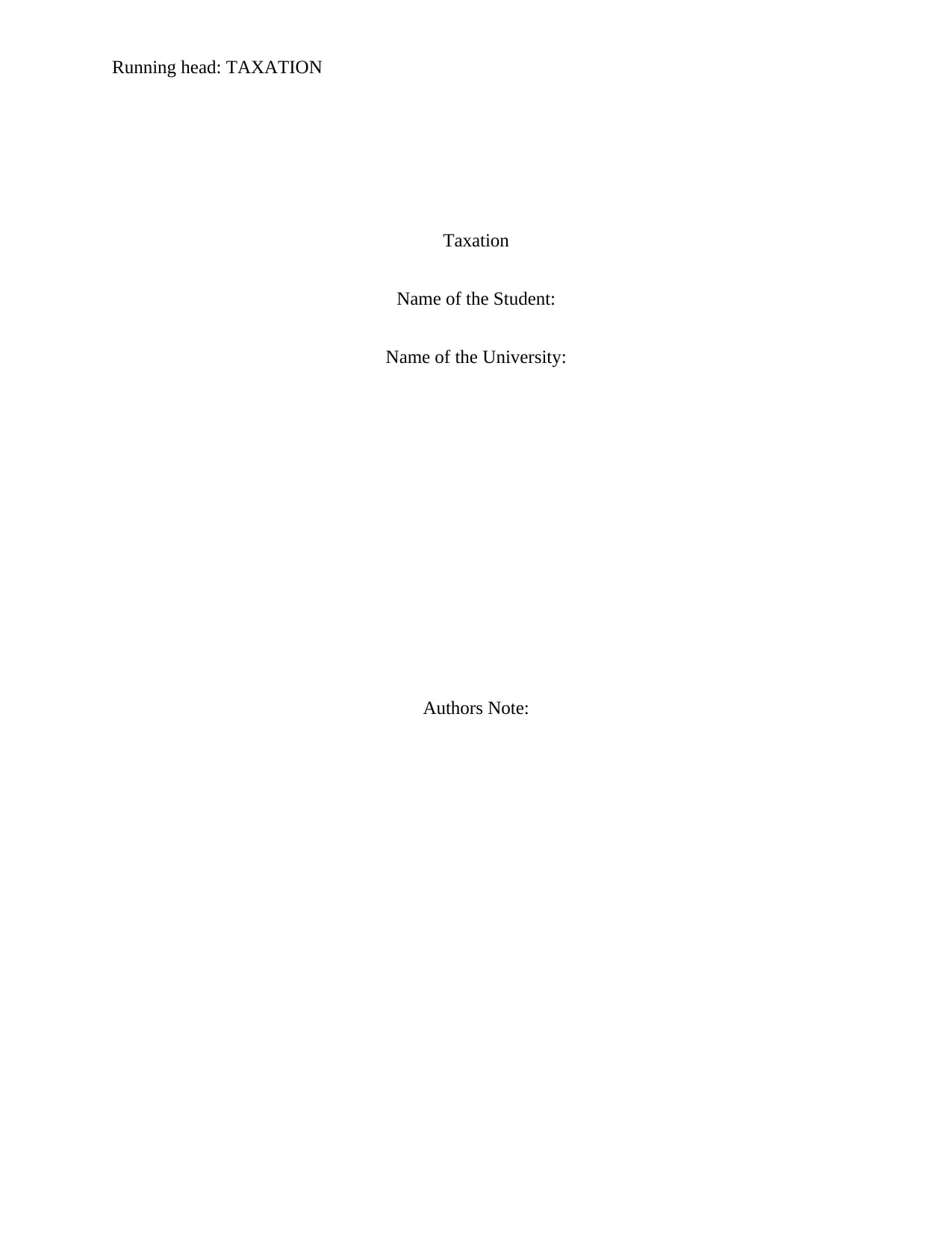
Running head: TAXATION
Taxation
Name of the Student:
Name of the University:
Authors Note:
Taxation
Name of the Student:
Name of the University:
Authors Note:
Paraphrase This Document
Need a fresh take? Get an instant paraphrase of this document with our AI Paraphraser
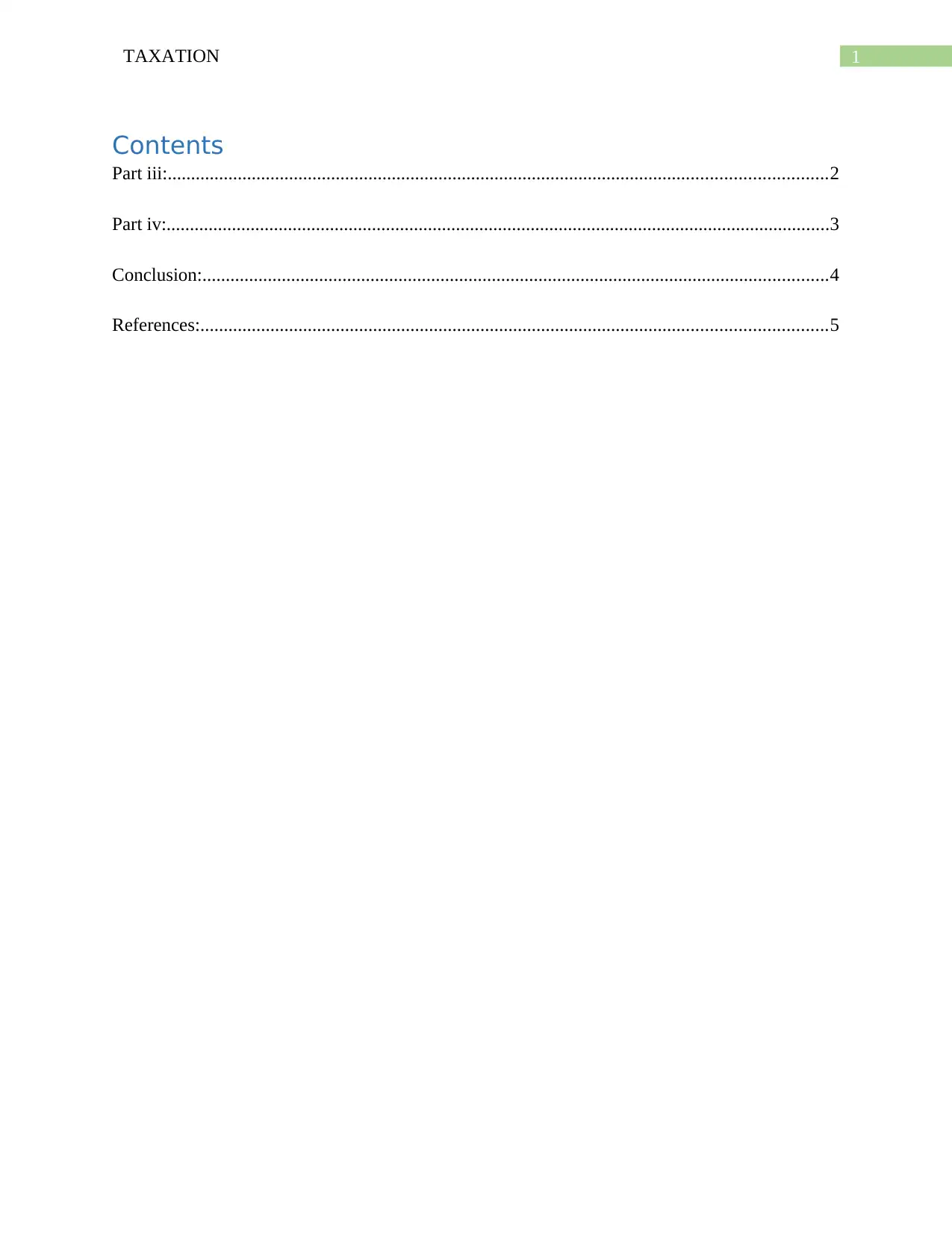
1TAXATION
Contents
Part iii:.............................................................................................................................................2
Part iv:..............................................................................................................................................3
Conclusion:......................................................................................................................................4
References:......................................................................................................................................5
Contents
Part iii:.............................................................................................................................................2
Part iv:..............................................................................................................................................3
Conclusion:......................................................................................................................................4
References:......................................................................................................................................5
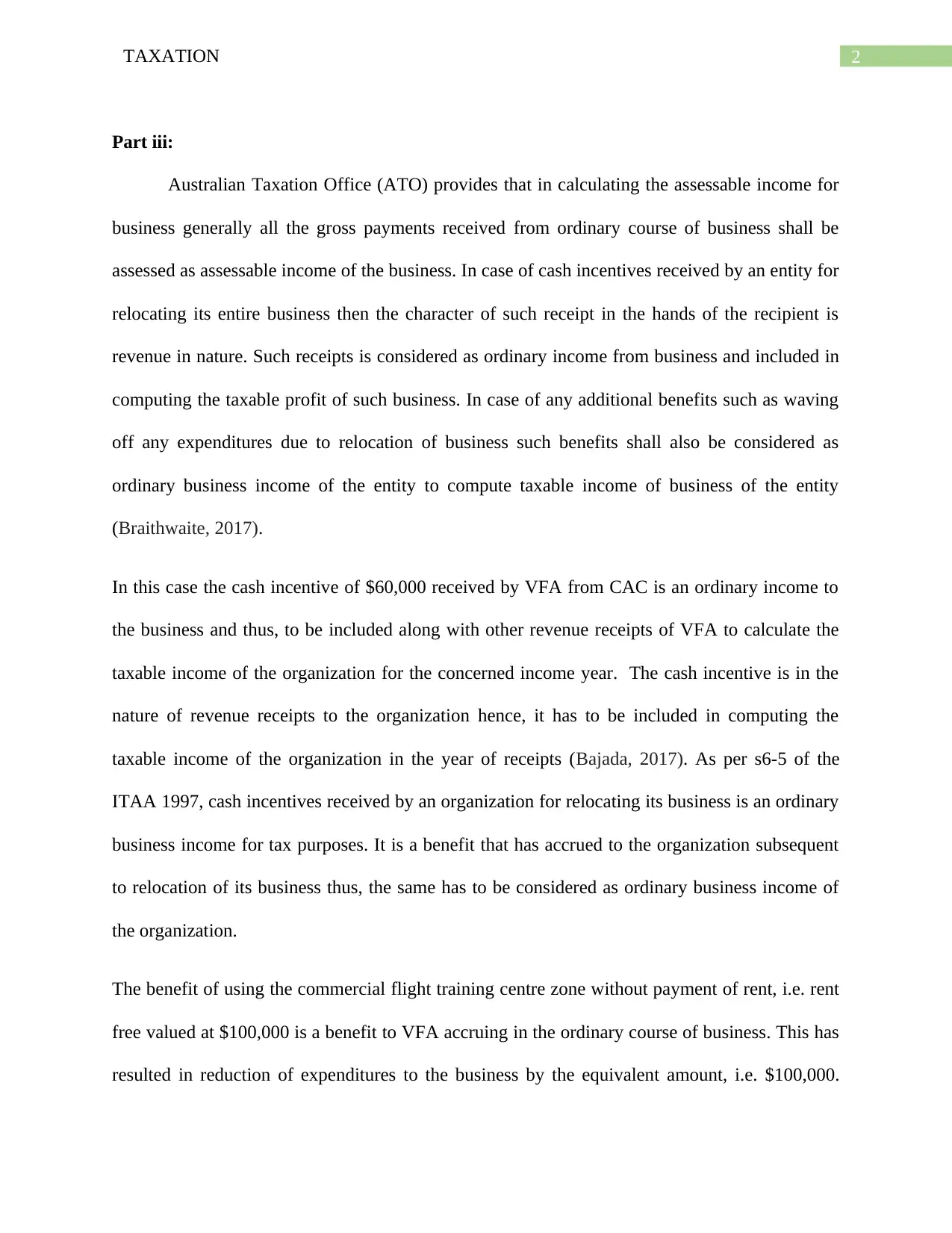
2TAXATION
Part iii:
Australian Taxation Office (ATO) provides that in calculating the assessable income for
business generally all the gross payments received from ordinary course of business shall be
assessed as assessable income of the business. In case of cash incentives received by an entity for
relocating its entire business then the character of such receipt in the hands of the recipient is
revenue in nature. Such receipts is considered as ordinary income from business and included in
computing the taxable profit of such business. In case of any additional benefits such as waving
off any expenditures due to relocation of business such benefits shall also be considered as
ordinary business income of the entity to compute taxable income of business of the entity
(Braithwaite, 2017).
In this case the cash incentive of $60,000 received by VFA from CAC is an ordinary income to
the business and thus, to be included along with other revenue receipts of VFA to calculate the
taxable income of the organization for the concerned income year. The cash incentive is in the
nature of revenue receipts to the organization hence, it has to be included in computing the
taxable income of the organization in the year of receipts (Bajada, 2017). As per s6-5 of the
ITAA 1997, cash incentives received by an organization for relocating its business is an ordinary
business income for tax purposes. It is a benefit that has accrued to the organization subsequent
to relocation of its business thus, the same has to be considered as ordinary business income of
the organization.
The benefit of using the commercial flight training centre zone without payment of rent, i.e. rent
free valued at $100,000 is a benefit to VFA accruing in the ordinary course of business. This has
resulted in reduction of expenditures to the business by the equivalent amount, i.e. $100,000.
Part iii:
Australian Taxation Office (ATO) provides that in calculating the assessable income for
business generally all the gross payments received from ordinary course of business shall be
assessed as assessable income of the business. In case of cash incentives received by an entity for
relocating its entire business then the character of such receipt in the hands of the recipient is
revenue in nature. Such receipts is considered as ordinary income from business and included in
computing the taxable profit of such business. In case of any additional benefits such as waving
off any expenditures due to relocation of business such benefits shall also be considered as
ordinary business income of the entity to compute taxable income of business of the entity
(Braithwaite, 2017).
In this case the cash incentive of $60,000 received by VFA from CAC is an ordinary income to
the business and thus, to be included along with other revenue receipts of VFA to calculate the
taxable income of the organization for the concerned income year. The cash incentive is in the
nature of revenue receipts to the organization hence, it has to be included in computing the
taxable income of the organization in the year of receipts (Bajada, 2017). As per s6-5 of the
ITAA 1997, cash incentives received by an organization for relocating its business is an ordinary
business income for tax purposes. It is a benefit that has accrued to the organization subsequent
to relocation of its business thus, the same has to be considered as ordinary business income of
the organization.
The benefit of using the commercial flight training centre zone without payment of rent, i.e. rent
free valued at $100,000 is a benefit to VFA accruing in the ordinary course of business. This has
resulted in reduction of expenditures to the business by the equivalent amount, i.e. $100,000.
⊘ This is a preview!⊘
Do you want full access?
Subscribe today to unlock all pages.

Trusted by 1+ million students worldwide
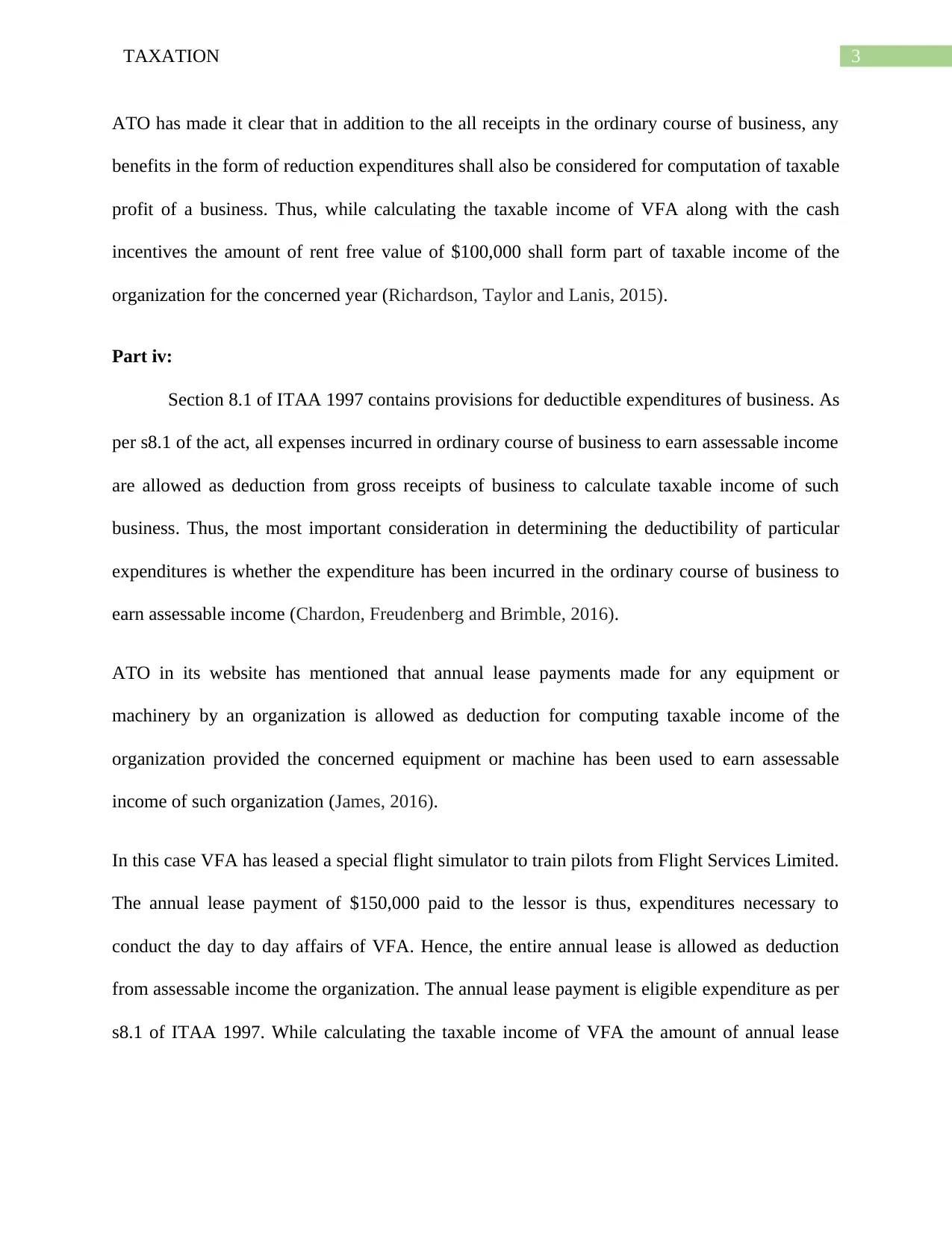
3TAXATION
ATO has made it clear that in addition to the all receipts in the ordinary course of business, any
benefits in the form of reduction expenditures shall also be considered for computation of taxable
profit of a business. Thus, while calculating the taxable income of VFA along with the cash
incentives the amount of rent free value of $100,000 shall form part of taxable income of the
organization for the concerned year (Richardson, Taylor and Lanis, 2015).
Part iv:
Section 8.1 of ITAA 1997 contains provisions for deductible expenditures of business. As
per s8.1 of the act, all expenses incurred in ordinary course of business to earn assessable income
are allowed as deduction from gross receipts of business to calculate taxable income of such
business. Thus, the most important consideration in determining the deductibility of particular
expenditures is whether the expenditure has been incurred in the ordinary course of business to
earn assessable income (Chardon, Freudenberg and Brimble, 2016).
ATO in its website has mentioned that annual lease payments made for any equipment or
machinery by an organization is allowed as deduction for computing taxable income of the
organization provided the concerned equipment or machine has been used to earn assessable
income of such organization (James, 2016).
In this case VFA has leased a special flight simulator to train pilots from Flight Services Limited.
The annual lease payment of $150,000 paid to the lessor is thus, expenditures necessary to
conduct the day to day affairs of VFA. Hence, the entire annual lease is allowed as deduction
from assessable income the organization. The annual lease payment is eligible expenditure as per
s8.1 of ITAA 1997. While calculating the taxable income of VFA the amount of annual lease
ATO has made it clear that in addition to the all receipts in the ordinary course of business, any
benefits in the form of reduction expenditures shall also be considered for computation of taxable
profit of a business. Thus, while calculating the taxable income of VFA along with the cash
incentives the amount of rent free value of $100,000 shall form part of taxable income of the
organization for the concerned year (Richardson, Taylor and Lanis, 2015).
Part iv:
Section 8.1 of ITAA 1997 contains provisions for deductible expenditures of business. As
per s8.1 of the act, all expenses incurred in ordinary course of business to earn assessable income
are allowed as deduction from gross receipts of business to calculate taxable income of such
business. Thus, the most important consideration in determining the deductibility of particular
expenditures is whether the expenditure has been incurred in the ordinary course of business to
earn assessable income (Chardon, Freudenberg and Brimble, 2016).
ATO in its website has mentioned that annual lease payments made for any equipment or
machinery by an organization is allowed as deduction for computing taxable income of the
organization provided the concerned equipment or machine has been used to earn assessable
income of such organization (James, 2016).
In this case VFA has leased a special flight simulator to train pilots from Flight Services Limited.
The annual lease payment of $150,000 paid to the lessor is thus, expenditures necessary to
conduct the day to day affairs of VFA. Hence, the entire annual lease is allowed as deduction
from assessable income the organization. The annual lease payment is eligible expenditure as per
s8.1 of ITAA 1997. While calculating the taxable income of VFA the amount of annual lease
Paraphrase This Document
Need a fresh take? Get an instant paraphrase of this document with our AI Paraphraser
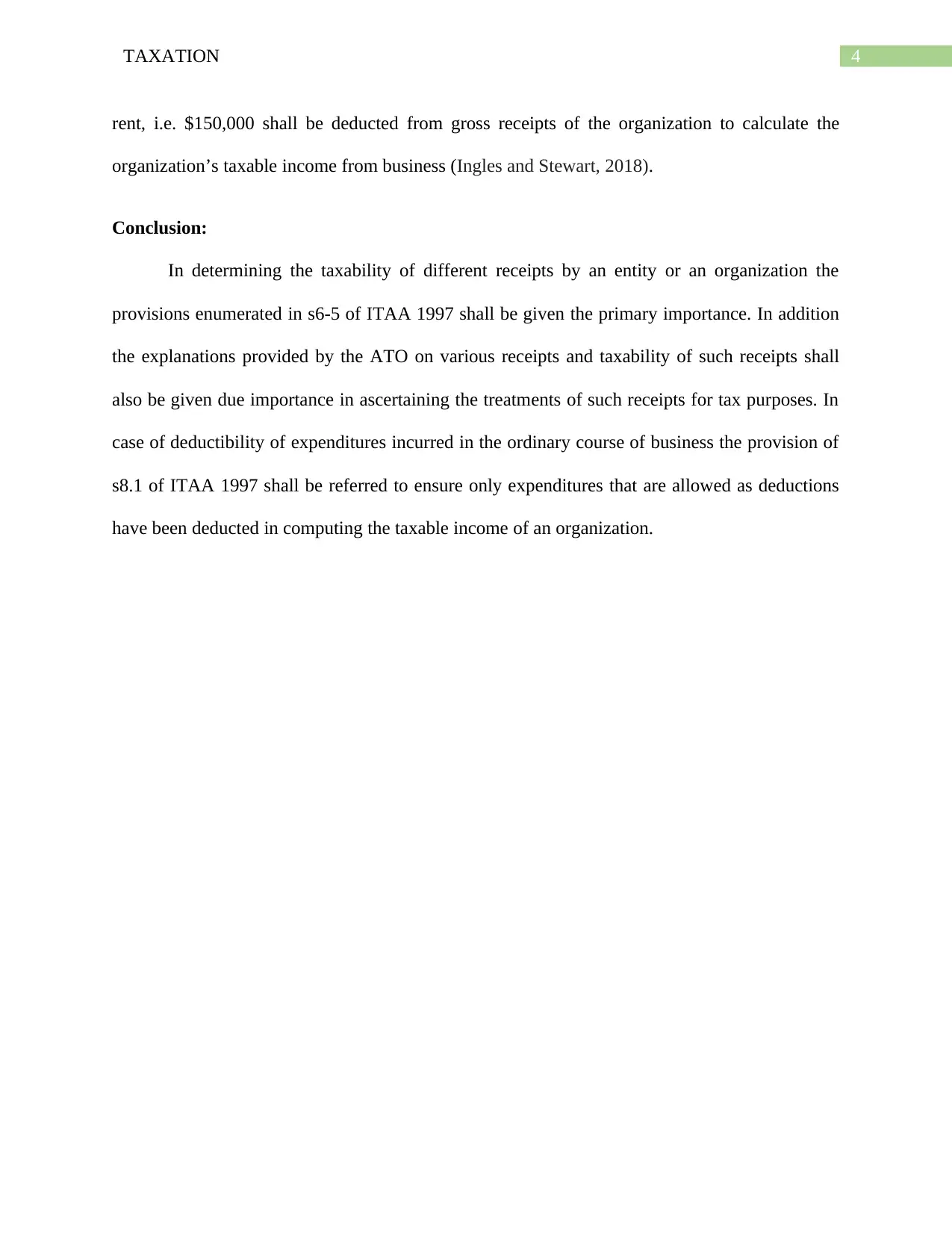
4TAXATION
rent, i.e. $150,000 shall be deducted from gross receipts of the organization to calculate the
organization’s taxable income from business (Ingles and Stewart, 2018).
Conclusion:
In determining the taxability of different receipts by an entity or an organization the
provisions enumerated in s6-5 of ITAA 1997 shall be given the primary importance. In addition
the explanations provided by the ATO on various receipts and taxability of such receipts shall
also be given due importance in ascertaining the treatments of such receipts for tax purposes. In
case of deductibility of expenditures incurred in the ordinary course of business the provision of
s8.1 of ITAA 1997 shall be referred to ensure only expenditures that are allowed as deductions
have been deducted in computing the taxable income of an organization.
rent, i.e. $150,000 shall be deducted from gross receipts of the organization to calculate the
organization’s taxable income from business (Ingles and Stewart, 2018).
Conclusion:
In determining the taxability of different receipts by an entity or an organization the
provisions enumerated in s6-5 of ITAA 1997 shall be given the primary importance. In addition
the explanations provided by the ATO on various receipts and taxability of such receipts shall
also be given due importance in ascertaining the treatments of such receipts for tax purposes. In
case of deductibility of expenditures incurred in the ordinary course of business the provision of
s8.1 of ITAA 1997 shall be referred to ensure only expenditures that are allowed as deductions
have been deducted in computing the taxable income of an organization.
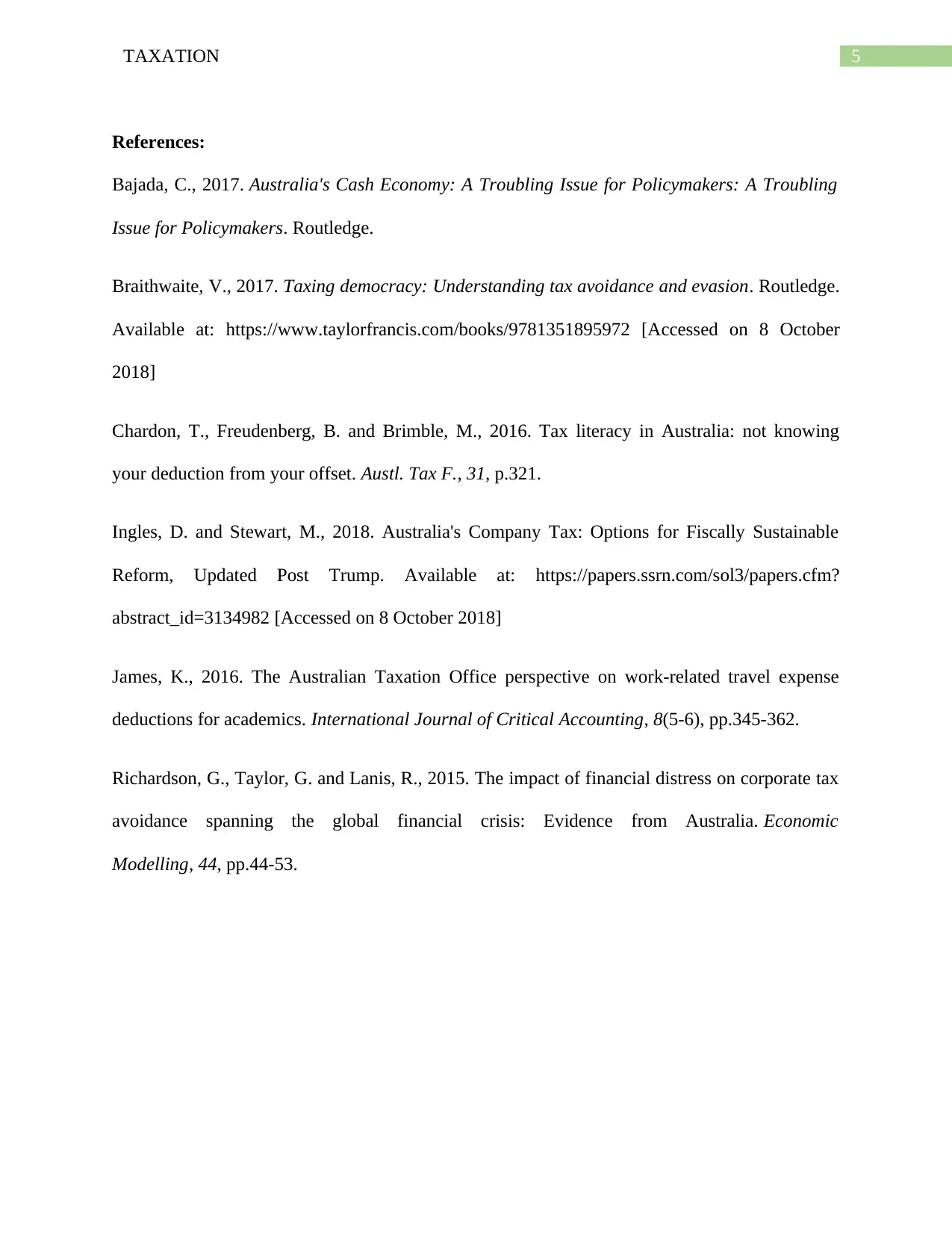
5TAXATION
References:
Bajada, C., 2017. Australia's Cash Economy: A Troubling Issue for Policymakers: A Troubling
Issue for Policymakers. Routledge.
Braithwaite, V., 2017. Taxing democracy: Understanding tax avoidance and evasion. Routledge.
Available at: https://www.taylorfrancis.com/books/9781351895972 [Accessed on 8 October
2018]
Chardon, T., Freudenberg, B. and Brimble, M., 2016. Tax literacy in Australia: not knowing
your deduction from your offset. Austl. Tax F., 31, p.321.
Ingles, D. and Stewart, M., 2018. Australia's Company Tax: Options for Fiscally Sustainable
Reform, Updated Post Trump. Available at: https://papers.ssrn.com/sol3/papers.cfm?
abstract_id=3134982 [Accessed on 8 October 2018]
James, K., 2016. The Australian Taxation Office perspective on work-related travel expense
deductions for academics. International Journal of Critical Accounting, 8(5-6), pp.345-362.
Richardson, G., Taylor, G. and Lanis, R., 2015. The impact of financial distress on corporate tax
avoidance spanning the global financial crisis: Evidence from Australia. Economic
Modelling, 44, pp.44-53.
References:
Bajada, C., 2017. Australia's Cash Economy: A Troubling Issue for Policymakers: A Troubling
Issue for Policymakers. Routledge.
Braithwaite, V., 2017. Taxing democracy: Understanding tax avoidance and evasion. Routledge.
Available at: https://www.taylorfrancis.com/books/9781351895972 [Accessed on 8 October
2018]
Chardon, T., Freudenberg, B. and Brimble, M., 2016. Tax literacy in Australia: not knowing
your deduction from your offset. Austl. Tax F., 31, p.321.
Ingles, D. and Stewart, M., 2018. Australia's Company Tax: Options for Fiscally Sustainable
Reform, Updated Post Trump. Available at: https://papers.ssrn.com/sol3/papers.cfm?
abstract_id=3134982 [Accessed on 8 October 2018]
James, K., 2016. The Australian Taxation Office perspective on work-related travel expense
deductions for academics. International Journal of Critical Accounting, 8(5-6), pp.345-362.
Richardson, G., Taylor, G. and Lanis, R., 2015. The impact of financial distress on corporate tax
avoidance spanning the global financial crisis: Evidence from Australia. Economic
Modelling, 44, pp.44-53.
⊘ This is a preview!⊘
Do you want full access?
Subscribe today to unlock all pages.

Trusted by 1+ million students worldwide
1 out of 6
Related Documents
Your All-in-One AI-Powered Toolkit for Academic Success.
+13062052269
info@desklib.com
Available 24*7 on WhatsApp / Email
![[object Object]](/_next/static/media/star-bottom.7253800d.svg)
Unlock your academic potential
Copyright © 2020–2025 A2Z Services. All Rights Reserved. Developed and managed by ZUCOL.





